A gleaming new showcase for the Acropolis - latimes.com
Posted using ShareThis
January 27, 2010
NEWS
27/01/2010
Antique vases pulled up from seabed
DIVERS on marine digs in the Aegean Sea discovered a cargo of antique ceramic vases from a shipwreck, the Greek culture and tourism ministry said today.
The vases from the fourth and fifth century BC were pulled up from depths of between 25 to 49 metres off the coast of the Polyaigos island, southwest of the Cyclades archipelago, located between Greece and Turkey in the Aegean Sea.
The finds by the aquatic archaeologists, including vases used for transportation and two small table vases, all intact, as well as fragments of the vessel's anchor, shed light on commercial routes during the period.
Greek authorities have been mapping its seabeds for a few years, sometimes cooperating with international institutes, and have so far located several dozen old shipwrecks.
Source www.heraldsun.com.au
more...
Antique vases pulled up from seabed
DIVERS on marine digs in the Aegean Sea discovered a cargo of antique ceramic vases from a shipwreck, the Greek culture and tourism ministry said today.
The vases from the fourth and fifth century BC were pulled up from depths of between 25 to 49 metres off the coast of the Polyaigos island, southwest of the Cyclades archipelago, located between Greece and Turkey in the Aegean Sea.
The finds by the aquatic archaeologists, including vases used for transportation and two small table vases, all intact, as well as fragments of the vessel's anchor, shed light on commercial routes during the period.
Greek authorities have been mapping its seabeds for a few years, sometimes cooperating with international institutes, and have so far located several dozen old shipwrecks.
Source www.heraldsun.com.au
more...
January 25, 2010
January 24, 2010
Visiting Greece in the Winter
Vacationing in Greece is a pleasure in any season. Most folks opt to visit Greece during the summer months, when the sun is high and the surf is warm. But little do people know that a visit to Greece during the winter months can be equally as exciting and fulfilling, and even more steeped in pure Greek culture.
The benefits of visiting Greece in the winter months (considered December through March) are that while most of the other tourists are off vacationing elsewhere, those who call Greece their home embrace the off-season tourists with a first-hand look at what it means to be Greek.
For those of us who enjoy a little less of the tourism factor in our vacations, Greece in the winter is the ideal get-away. Hiking, biking, any exploration of nature is easier now, with the slightly cooler weather, and the number of other tourists at a minimum. Winter is the time to delight in the food the locals savor, to enjoy the nightlife known only to the locals and to participate in some activities and celebrations the locals relish only with their own.
Skiing in Greece is an after thought, or nonexistent one for most looking to vacation, while in fact, Greece provides some of the best skiing mountains in the world. Macedonia, Pelion, the Peloponnesus, Pelion and other cities to the north have ski centers and chalet type buildings in the mountains that provide ski lifts for downhill as well as cross-country runs.
Because Greece is blessed with such a temperate climate and beautiful natural environment, sailing in the winter is also a preferred sport by some. The cooler weather and less hustle and bustle from tourist crowds make it easier and even more enjoyable to sail and enjoy the natural surroundings. Whether it is bird watching, or ruins exploration.
Island culture abounds in the winter months, when tourists do not outnumber the locals. The usual tourist spots that are open in the summer months tend to close come wintertime. This means that the establishments that are open, are regular spots the locals visit. In turn, this generally means better Greek food to enjoy, and better yet, deeper, richer Greek culture including dog slide races, river wild rafting, and Alpine skiing.
Another great positive for enjoying Greece in the off-season, is of course, the lower rates. Traveling over seas is already costly enough, but if Greece is calling you, add lower rates on everything from airfare to hotel rates to the list of positives.
Apokreas, or carnival season, takes place in Greece around the end of February. The island of Skyros, Athens and Patras hold huge celebrations at this time of year. Apokreas refers to the time right before the 40 days of fasting before Easter begins. This involves feasting, celebrating, drinking and dancing - every night. What better way to see Greece than during this time, when many locals are celebrating more than they do the rest of the year?
More reasons to enjoy Greece in the winter time is that ferries are always running to and from the mainland to the islands. If the weather becomes questionable or nasty, travel may become difficult, but for the most part, winter weather still tends to be quite exceptional.
The ruins are much more enjoyable to visit during the winter. The crowds are not in place, and neither is the heat. So it is easy to linger among the ruins, such as the Acropolis, the monasteries on top of the rock towers in Meteora or the Oracle of Delphi. One of the most amazing views of Athens can be seen from the Acropolis at sunset. Part of the reasoning behind visiting Greece is, no doubt, to explore the history of the native land, and the ancient ruins, so why would not someone want to take as much time as possible?
The picking of olives and production of olive oil is an important aspect of living in Greece. Homer referred to it as a "liquid gold" which is more a true statement today then he could have ever believed. A full 60% of Greece's cultivated land is devoted to growing olives. The fruit is hand picked by families and even relatives and neighbors join in on the fun. Since this process generally starts toward the end of the year, those visiting Greece during the winter can help pick olives themselves, and really be a part of Greek family traditions.
With so many reasons to visit Greece during the winter months, how could anyone who is thinking of planning a trip not be seduced by the history and natural beauty that are in abundance in this amazing Mediterranean country.
The benefits of visiting Greece in the winter months (considered December through March) are that while most of the other tourists are off vacationing elsewhere, those who call Greece their home embrace the off-season tourists with a first-hand look at what it means to be Greek.
For those of us who enjoy a little less of the tourism factor in our vacations, Greece in the winter is the ideal get-away. Hiking, biking, any exploration of nature is easier now, with the slightly cooler weather, and the number of other tourists at a minimum. Winter is the time to delight in the food the locals savor, to enjoy the nightlife known only to the locals and to participate in some activities and celebrations the locals relish only with their own.
Skiing in Greece is an after thought, or nonexistent one for most looking to vacation, while in fact, Greece provides some of the best skiing mountains in the world. Macedonia, Pelion, the Peloponnesus, Pelion and other cities to the north have ski centers and chalet type buildings in the mountains that provide ski lifts for downhill as well as cross-country runs.
Because Greece is blessed with such a temperate climate and beautiful natural environment, sailing in the winter is also a preferred sport by some. The cooler weather and less hustle and bustle from tourist crowds make it easier and even more enjoyable to sail and enjoy the natural surroundings. Whether it is bird watching, or ruins exploration.
Island culture abounds in the winter months, when tourists do not outnumber the locals. The usual tourist spots that are open in the summer months tend to close come wintertime. This means that the establishments that are open, are regular spots the locals visit. In turn, this generally means better Greek food to enjoy, and better yet, deeper, richer Greek culture including dog slide races, river wild rafting, and Alpine skiing.
Another great positive for enjoying Greece in the off-season, is of course, the lower rates. Traveling over seas is already costly enough, but if Greece is calling you, add lower rates on everything from airfare to hotel rates to the list of positives.
Apokreas, or carnival season, takes place in Greece around the end of February. The island of Skyros, Athens and Patras hold huge celebrations at this time of year. Apokreas refers to the time right before the 40 days of fasting before Easter begins. This involves feasting, celebrating, drinking and dancing - every night. What better way to see Greece than during this time, when many locals are celebrating more than they do the rest of the year?
More reasons to enjoy Greece in the winter time is that ferries are always running to and from the mainland to the islands. If the weather becomes questionable or nasty, travel may become difficult, but for the most part, winter weather still tends to be quite exceptional.
The ruins are much more enjoyable to visit during the winter. The crowds are not in place, and neither is the heat. So it is easy to linger among the ruins, such as the Acropolis, the monasteries on top of the rock towers in Meteora or the Oracle of Delphi. One of the most amazing views of Athens can be seen from the Acropolis at sunset. Part of the reasoning behind visiting Greece is, no doubt, to explore the history of the native land, and the ancient ruins, so why would not someone want to take as much time as possible?
The picking of olives and production of olive oil is an important aspect of living in Greece. Homer referred to it as a "liquid gold" which is more a true statement today then he could have ever believed. A full 60% of Greece's cultivated land is devoted to growing olives. The fruit is hand picked by families and even relatives and neighbors join in on the fun. Since this process generally starts toward the end of the year, those visiting Greece during the winter can help pick olives themselves, and really be a part of Greek family traditions.
With so many reasons to visit Greece during the winter months, how could anyone who is thinking of planning a trip not be seduced by the history and natural beauty that are in abundance in this amazing Mediterranean country.
January 22, 2010
Greek Tavernas - Your Top 10 Tips When Eating Out in Greece
Greek tavernas are a great traditional place to experience the best in Greek cuisine. When you are eating out in Greece, you can be assured of a great time. Good food, great service and wonderful atmosphere. There are some things you need to know to help you get the most out of the experience.
These top 10 tips will apply to the vast majority of Greek tavernas you visit in the resorts of Greece and Crete.
Tip #1
Many Greek tavernas have uncomfortable seating. So if you haven't your own personal padding, or there are no cushions available, be prepared to walk or limp away with a dull pain in the backside.
Tip #2
After visiting a few tavernas you'll soon notice that menus are very similar. Good, simple, wholesome Greek food which is fresh, seasonal and plentiful finds its way onto every menu -- and not much more.
Tip #3
When choosing from the menu always factor in a second or even third choice. Due to the seasonal and fresh nature of the foods sourced by tavernas, some ingredients are unavailable at certain times of the year. Don't, for example, expect strawberries after May or June, or expect grapes before August.
Tip #4
Starters can come served with the main course - or sometimes after! Also don't expect a main course to contain "meat and two veg" -- it won't. If you want vegetables you'll need to order these separately.
Tip #5
Food is often served at room temperature and will NOT always be piping hot.
Tip #6
Cutlery will normally be found in the bread basket that accompanies every meal. You will not normally be given an extra set of cutlery for each course -- so try to hold onto your knife and fork!
Tip #7
Expect slower service than you are used to. Take your time, relax and enjoy your meal. Dining can take two hours on average. From asking for your bill to actually leaving the restaurant can take up to a further hour.
Tip #8
A comprehensive sweets, pudding or desserts menu is rare. You won't need one! However you will be given, free of charge, a small dessert of fresh fruit, traditional sweet pastries or ice cream.
Tip #9
Expect a complimentary alcoholic drink such as a carafe of Raki (local fire water, especially in Crete) or jug of wine, or a glass of Metaxa (Greek brandy) after you've asked for the bill. This is served with the complimentary desert.
Tip #10
Your bill will generally be far less expensive that you think, so always leave a generous tip!
One last thing, olive oil is one of the most important ingredients in Greek food. Don't think it's just oil, it is in fact one of the healthiest and most natural foods in the world, and is the juice of the olive. Both the inhabitants of Crete (especially) and Greeks in general, lash their dishes with this precious oil, so don't be afraid - enjoy it!
To learn more about vacations and living on the Greek islands visit http://www.completely-crete.com/ and http://www.simply-santorini.com/.
These top 10 tips will apply to the vast majority of Greek tavernas you visit in the resorts of Greece and Crete.
Tip #1
Many Greek tavernas have uncomfortable seating. So if you haven't your own personal padding, or there are no cushions available, be prepared to walk or limp away with a dull pain in the backside.
Tip #2
After visiting a few tavernas you'll soon notice that menus are very similar. Good, simple, wholesome Greek food which is fresh, seasonal and plentiful finds its way onto every menu -- and not much more.
Tip #3
When choosing from the menu always factor in a second or even third choice. Due to the seasonal and fresh nature of the foods sourced by tavernas, some ingredients are unavailable at certain times of the year. Don't, for example, expect strawberries after May or June, or expect grapes before August.
Tip #4
Starters can come served with the main course - or sometimes after! Also don't expect a main course to contain "meat and two veg" -- it won't. If you want vegetables you'll need to order these separately.
Tip #5
Food is often served at room temperature and will NOT always be piping hot.
Tip #6
Cutlery will normally be found in the bread basket that accompanies every meal. You will not normally be given an extra set of cutlery for each course -- so try to hold onto your knife and fork!
Tip #7
Expect slower service than you are used to. Take your time, relax and enjoy your meal. Dining can take two hours on average. From asking for your bill to actually leaving the restaurant can take up to a further hour.
Tip #8
A comprehensive sweets, pudding or desserts menu is rare. You won't need one! However you will be given, free of charge, a small dessert of fresh fruit, traditional sweet pastries or ice cream.
Tip #9
Expect a complimentary alcoholic drink such as a carafe of Raki (local fire water, especially in Crete) or jug of wine, or a glass of Metaxa (Greek brandy) after you've asked for the bill. This is served with the complimentary desert.
Tip #10
Your bill will generally be far less expensive that you think, so always leave a generous tip!
One last thing, olive oil is one of the most important ingredients in Greek food. Don't think it's just oil, it is in fact one of the healthiest and most natural foods in the world, and is the juice of the olive. Both the inhabitants of Crete (especially) and Greeks in general, lash their dishes with this precious oil, so don't be afraid - enjoy it!
To learn more about vacations and living on the Greek islands visit http://www.completely-crete.com/ and http://www.simply-santorini.com/.
January 18, 2010
The Art of World Cuisines




You only have to take a look around the famous art galleries of the world and you can see how food has influenced and inspired the creation of beautiful, fascinating and extraordinary artwork. Chefs from every nation also view cuisine as an art form and express this through the preparation, use of ingredients and the presentation of the dishes they design.
The definition of cuisine is 'a characteristic manner or style of preparing food'. Cooking is diverse in its flavors and tastes, not only does each country have its own national cuisine, so does every region within that country, and even families are known to have a special recipe that has been passed down through the generations.
As travel to foreign countries becomes more accessible, part of the fun of traveling is to find out about other cultures and explore the regions cuisine, delighting in tastes and flavors never experienced before can help you to understand the country and its people. Travel also enables our taste buds to change, there was a time when eating pasta, Indian or Mexican food would be only for the adventuress, now it is easily accessible to most people.
Cuisines are influenced by the ingredients and traditions afforded to them. They have evolved not only from the produce and spices that are grown locally, but also the way the food is prepared, the cooking utensils used, and traditions and customs, even trade routes and religion have had an impact on a particular cuisine.
In most cities these days it is easy to find international restaurants selling a variety of cuisines from all over the world. We now not only have access to our own traditional food but also can choose to eat Chinese, Thai, Indian, Italian or Greek just as easily. New cuisines are introduced all the time as a generation of original chefs comes up with new ideas and recipes.
Indian food has been influenced, and influenced, many cuisines. Mongolians brought India their hot pot cooking, Persian rulers brought their own ingredients and style of cooking with them, the Chinese came to trade and along the way introduced stir fry's, and the Portuguese contributed tomato, chilli, and potato, basic ingredients of today's Indian cuisine. For simple Indian recipes try Tandoori chicken, just skin chicken drumsticks and make the paste by mixing together yogurt, tomato paste, ginger, garlic, lemon juice, vinegar, salt, pepper and garam masala. Marinate for six hours and enjoy.
Greek cuisine has an abundance of delectable Greek foods prepared by using the ingredients found growing in the surrounding areas, found in almost every dish is olive oil as it grows freely and is in abundance throughout the region. Bread, wine, fish, and meats are a staple of Greek food, which is well-known for its healthy aspects. Typically Mediterranean, Greek recipes often have qualities akin to the cuisines of Southern France, Italy, Turkey and the Middle East. Favorites include Moussakas and baklavas, and Italian influenced dishes, such as pastitsio which is a layered baked dish. For authentic Greek recipes, try making Tzatziki, simply peel and seed cucumbers, then mash garlic with olive oil, salt and pepper. Stir in the cucumbers and yogurt and chill.
To learn the art of a particular style of cooking, such as Asian or Italian, is to study the culture of the region. You can't expect to look up a recipe, and re-create it exactly the same as you would if it were produced in the country from which it originates. Each recipe requires modification and adapting to suit the tastes of the diner. If you want to re-create a particular dish but can't find the exact ingredients in your local shop, either use a substitute or check online where you might find it can be ordered. Exotic and free recipes from different cultures can easily be found in magazines, books and on the Internet.
There are plenty of websites that let food lovers of all cooking levels to trade recipes and chat with people who share their passion for food and cooking. Connecting with others can result in shared information, a wider range of recipes and some top tips.
There are thousands of free recipes online for interesting, quick and easy meals. Find cooking recipes along with pictures, reviews, tips and ratings to help you plan your ideal meal. If you are searching for free international recipes check out recipes by cuisine, find Indian and Greek recipes amongst many others. Now there's no longer the need to travel to another country to get a taste of the foods you love.
Michiel Van Kets provides article services for Rebecca Goldman who works for Recipe Awards, a website where a visitor can find thousands of recipes online for quick and easy meals. You'll find free international recipes from hot celebrity chefs, as well as famous culinary institutes. For free recipes of diabetic cooking, low fat and vegetarian dishes, please visit the website.
Article Source: http://EzineArticles.com/?expert=Michiel_Van_Kets
Are Greek Island Holidays Really Worth It?
Greek Islands holidays are a dream for millions of people around the world. With all that is on offer there, it is easy to see why these islands continue to have such an irresistible appeal to so many people.
Greece is world famous for its legendary history, but there is a lot more to it than just a colorful past. Try searching for images of Greece and you will instantly see that it is one of the most scenic and beautiful countries not just in Europe, but in the whole world.
Even pictures of the landscape, beaches and historical settings can not to Greece justice though. You really need to see and experience the place first hand, so as to be able to appreciate the atmosphere that goes with the scenery.
One of the most intriguing elements of travel among the Greek Islands is that there are so many differences between each one. If you are lucky enough to spend 1-2 weeks exploring several of these charming island paradises you will soon discover that each of them possesses a special identity and beauty.
A popular choice with tourists is a visit to the Sardonic Gulf Islands which are close to Greece's mainland area. You can sign up for a day trip and easily travel to Aegina, Poros, Spetses, and Hydra.
The Sporades Islands might be the right choice for you if you are looking for a particularly quiet and intimate atmosphere. Located between northern and central Greece, these islands are said by many to have the most exotic landscapes in the country.
Continue reading about your very next holidays to Greek Islands at our information site dedicated to these fabulous islands in the Mediterranean.
Article Source: http://EzineArticles.com/?expert=Mark_Thomas_Walters
Greece is world famous for its legendary history, but there is a lot more to it than just a colorful past. Try searching for images of Greece and you will instantly see that it is one of the most scenic and beautiful countries not just in Europe, but in the whole world.
Even pictures of the landscape, beaches and historical settings can not to Greece justice though. You really need to see and experience the place first hand, so as to be able to appreciate the atmosphere that goes with the scenery.
One of the most intriguing elements of travel among the Greek Islands is that there are so many differences between each one. If you are lucky enough to spend 1-2 weeks exploring several of these charming island paradises you will soon discover that each of them possesses a special identity and beauty.
A popular choice with tourists is a visit to the Sardonic Gulf Islands which are close to Greece's mainland area. You can sign up for a day trip and easily travel to Aegina, Poros, Spetses, and Hydra.
The Sporades Islands might be the right choice for you if you are looking for a particularly quiet and intimate atmosphere. Located between northern and central Greece, these islands are said by many to have the most exotic landscapes in the country.
Continue reading about your very next holidays to Greek Islands at our information site dedicated to these fabulous islands in the Mediterranean.
Article Source: http://EzineArticles.com/?expert=Mark_Thomas_Walters
January 17, 2010
Athens, the Capital City of Greece
Are you planning to recently visit Athens, the Capital City of Greece or go vacations with your friends or family to any of the wonderful greek islands?
Then this is the best place to be and get all the information you need before you get there, from this great online guide.
Any visitor going to Athens, this beautiful ancient city, will naturally visit the Acropolis and its well-preserved marble structures,which is a must-see while in Athens. It is a nice hike from the base up to the top where you can see the ruins.
The views from the top are phenomenal and you can catch a nice breeze on a hot day . Also in August, several archeological sites in Greece stay open late for a full moon festival and if you are fortunate enough to be there on that time, you’ll have the opportunity to visit the Acropolis and the Parthenon under the light of the moon, while being surounded by various classical musicians and opera singers.
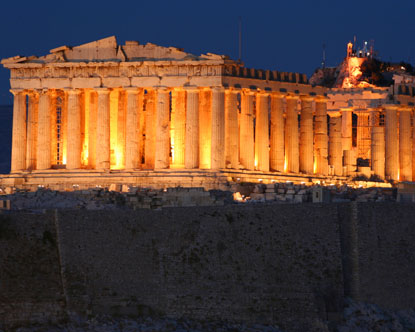 Parthenon: The most Holy Temple
Parthenon: The most Holy Temple
The New Acropolis Museum
Located at the foot of the Acropolis, the modern museum's five-stories of exterior glass walls reflect images of the Parthenon and surrounding ruins. The museum is the new home for hundreds of statues from the Archaic and Classical eras, but the Parthenon Gallery on the top floor is the museum's showcaseThe Acropolis Museum is an archaeological museum focused on the findings of the archaeological site of the Acropolis. The museum was built to house every artifact found on the rock and on its feet, from the Greek Bronze Age to Roman and Byzantine Greece. It also lies on the archaeological site of Makrygianni and the ruins of a part of Roman and early Byzantine city.It opened to the public on June 21, 2009. Nearly 4,000 objects are exhibited over an area of 14,000 square metres.
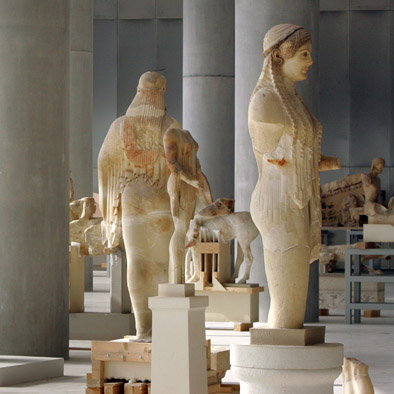
The Ancient Agora of Athens
The agora had private housing, until it was reorganized by Peisistratus in the 6th century BC. Although he may have lived on the agora himself, he removed the other houses, closed wells, and made it the centre of Athenian government. He also built a drainage system, fountains and a temple to the Olympian gods. Cimon later improved the agora by constructing new buildings and planting trees. In the 5th century BC there were temples constructed to Hephaestus, Zeus and Apollo.The agora in Athens again became a residential area during Roman and Byzantine times.
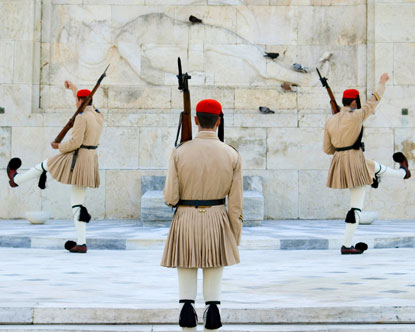 The changing of the Presidential Guards
The changing of the Presidential Guards
The Tomb of the Unknown soldier is in memory of all the anonymous Greek soldiers that have fallen in the battlefield- in front of the Parliament is a monument where Greek officials and visiting dignitaries lay wreaths on major holidays. It bears an inscription with the Funeral Speech of Pericles.
The National Garden
The National Garden is a peaceful, green refuge of 15.5 hectares in the center of the Greek capital. It is located directly behind the Greek Parliament building and continues to the south to the area where the Zappeion is located, across from the Panathenaiko or Kalimarmaro Olympic Stadium of the 1896 Olympic Games.The Garden was once the private garden of the palace - a project of Queen Amalia in the 1840’s. For the kids there is a small zoo housing domestic animals, a few ostriches and a playground.The Royal Garden was commissioned by Queen Amalia in 1838 and completed by 1840. It was designed by the German agronomist Frederick Schmidt who imported over 500 species of plants and a variety of animals including peacocks, ducks, and turtles. Unfortunately for many of the plants, the dry Mediterranean climate proved too harsh and they did not survive; animals continue to thrive. The upper garden, behind the Old Palace, was fenced off and was the private refuge of the King and Queen. The entry is free to the public.
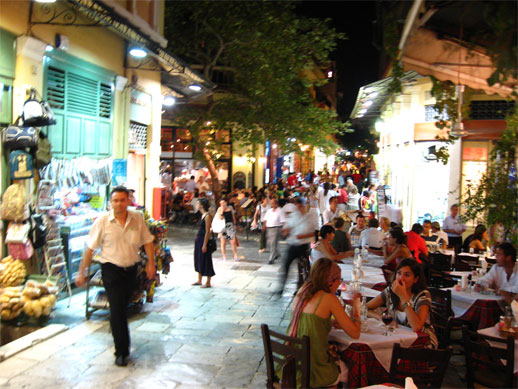 Plaka is the oldest section of Athens where the most of the streets have been closed to automobile traffic. Although it is quite commercialized it is still a neighborhood and arguably the nicest neighborhood in the city center.
Plaka is the oldest section of Athens where the most of the streets have been closed to automobile traffic. Although it is quite commercialized it is still a neighborhood and arguably the nicest neighborhood in the city center.
Plaka originates from the days of the Greek revolution. Under the Acropolis Plaka was built by the first construction workers that come from Anafi cycladic island and built the main buildings. The settlement of Anafiotika was created in the 19th century. They built their houses on the steep slopes of the Acropolis in their traditional island style. Thus, they created a small village with white-washed houses and narrow paths between them. The village comes complete with a tiny church dedicated to St George. A closer look will reveal that the marble used for the construction of the church was taken from an ancient temple. Today is the main touristic attraction.
Benaki Museum
The Benaki Museum's extensive collection and neo-classical mansion setting make the Benaki Museum one of the premier museums in Athens.The Benakis family was a prominent Greek family who maintained their wealth after the 1921 Greek War of Independence. The Benaki Museum was established in 1929, the year Emmanouil Benakis died. Born in Syros, Greece in 1843, Emmanouil would eventually become the mayor of Athens, after beginning political life in 1910The Benaki Museum can easily be accessed from Syntagma Square, the heart od Athens where the Parliament Building is located.
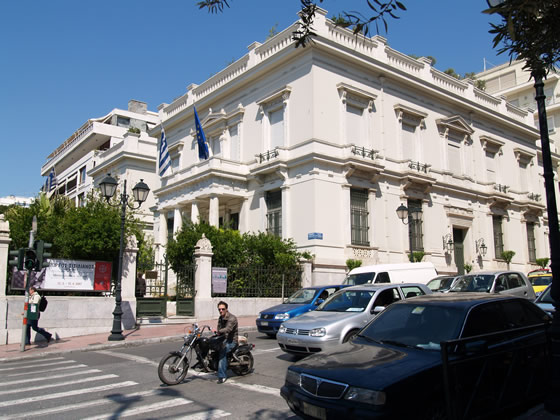
The Byzantine Museum
The Byzantine Museum was fonded in 1914 is one of the National Museums of Greece. Since 1930 it has been housed in the fine "Ilisia" building complex, erected near the river Ilisios in 1848 by the architect Stamatios Kleanthis for Sophia de Marbois the Duchess of Piacenza. There is a unique collection of icons ,sculptures , wall paintings, jewellery and other works of minor art from the 4th to the 19th century.
The National Gallery of Art
The Gallery was initially housed in a small area of Athens in the Technical University main building, where it remained until the outbreak of war in 1939. Substantial donations by Greek patriots as well as purchases continued to enrich the collections of the National Gallery. Its merger with the Alexandros Soutzos Estate in 1954, through the initiative of the then director Marinos Kalligas, contributed decisively to its development. The National Gallery, however, remained in effect homeless until 1976, leading a nomadic life, when the current building, begun in 1964, was completed and inaugurated, based on the designs of the architects professors Pavlos Milonas and Dimitris Fatouros.
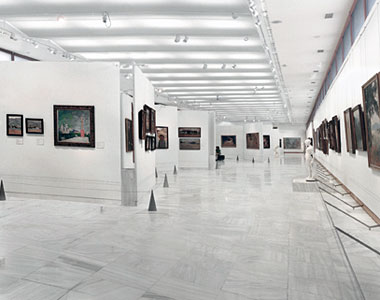
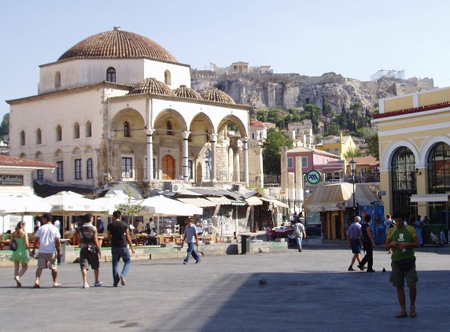 Monastiraki
Monastiraki
Monastiraki is the place that most of all represent tradition and tourist sightseeing at the same time. It’s placed under the shadow of Acropolis at the South West section of the magisterial Sacred Rock and next to the Ancient Market and Attalos loft. Monastiraki is famous for the flea market and it is a great place for a Sunday morning walk in Athens. An early visit in the morning will help as later on the crowd becomes impossible and there are tables available at the many cafes adn restaurants for a drink or a snack.
National Archaeological Museum
It is the most important archaeological museum in Greece and one of the richest in the world concerning ancient Greek art. Its collections are representative of all the cultures that flourished in Greece. The construction of the museum begun in 1866 and completed in 1889 with the gradual addition of the west wing in 1874, of the north in 1881, of the south in 1885 and finally of the east wing. The building was erected in a large plot donated by Helen Tositsa, with the financial support of Demetrios and Nicolaos Vernardakis, the Archaeological Society and the Greek state.
Tickets for the National Archaeological Museum
7 Euro
Museum Hours:
Monday 13.00-19.30 (1pm-7:30pm) Tuesday-Sunday 08.30-15.00 (8:30am-3pm)
Museum Telephone:00 30 210 8217717 or 00 30 210 8217724
Museum Email:protocol@eam.culture.gr
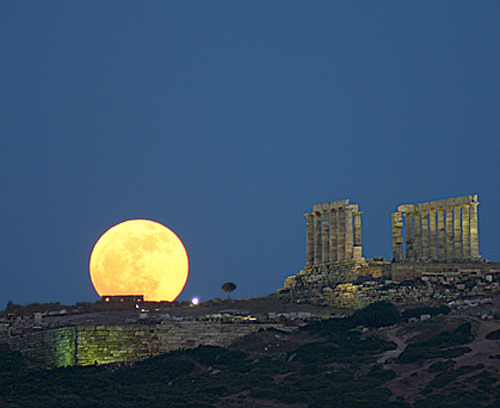 Poseidon Temple
Poseidon Temple
The sanctuary of Poseidon at Sounion is one of the most important sanctuaries in Attica. Sporadic finds point to the conclusion that the site was inhabited in the prehistoric period but there is no evidence of religious practice in such an early date. "Sounion Hiron" (sanctuary of Sounion) is first mentioned in the Odyssey, as the place where Menelaos stopped during his return from Troy to bury his helmsman, Phrontes Onetorides. The finds of the 7th century B.C. are numerous and proove the existence of organized cult on two points of the promontory: at the southern edge where the temenos of Poseidon was situated, and about 500 m. to the NE of it, where the sanctuary of Athena was established.
See more on
http://www.go-greece-vacations.com/greek-islands.html
Then this is the best place to be and get all the information you need before you get there, from this great online guide.
Any visitor going to Athens, this beautiful ancient city, will naturally visit the Acropolis and its well-preserved marble structures,which is a must-see while in Athens. It is a nice hike from the base up to the top where you can see the ruins.
The views from the top are phenomenal and you can catch a nice breeze on a hot day . Also in August, several archeological sites in Greece stay open late for a full moon festival and if you are fortunate enough to be there on that time, you’ll have the opportunity to visit the Acropolis and the Parthenon under the light of the moon, while being surounded by various classical musicians and opera singers.
 Parthenon: The most Holy Temple
Parthenon: The most Holy TempleThe architects Iktinos and Kallikrates are mentioned in History as the creators of Parthenon, the most famous greek temple, which was built in honour of Goddess Athena, the protector of the city of Athens.Admission to all participating sites is usually free and the public may visit from 7 pm to 1:30 am while some sites close as late as 3 am.
The New Acropolis Museum
Located at the foot of the Acropolis, the modern museum's five-stories of exterior glass walls reflect images of the Parthenon and surrounding ruins. The museum is the new home for hundreds of statues from the Archaic and Classical eras, but the Parthenon Gallery on the top floor is the museum's showcaseThe Acropolis Museum is an archaeological museum focused on the findings of the archaeological site of the Acropolis. The museum was built to house every artifact found on the rock and on its feet, from the Greek Bronze Age to Roman and Byzantine Greece. It also lies on the archaeological site of Makrygianni and the ruins of a part of Roman and early Byzantine city.It opened to the public on June 21, 2009. Nearly 4,000 objects are exhibited over an area of 14,000 square metres.

The Ancient Agora of Athens
The agora had private housing, until it was reorganized by Peisistratus in the 6th century BC. Although he may have lived on the agora himself, he removed the other houses, closed wells, and made it the centre of Athenian government. He also built a drainage system, fountains and a temple to the Olympian gods. Cimon later improved the agora by constructing new buildings and planting trees. In the 5th century BC there were temples constructed to Hephaestus, Zeus and Apollo.The agora in Athens again became a residential area during Roman and Byzantine times.
 The changing of the Presidential Guards
The changing of the Presidential GuardsThe Tomb of the Unknown soldier is in memory of all the anonymous Greek soldiers that have fallen in the battlefield- in front of the Parliament is a monument where Greek officials and visiting dignitaries lay wreaths on major holidays. It bears an inscription with the Funeral Speech of Pericles.
The National Garden
The National Garden is a peaceful, green refuge of 15.5 hectares in the center of the Greek capital. It is located directly behind the Greek Parliament building and continues to the south to the area where the Zappeion is located, across from the Panathenaiko or Kalimarmaro Olympic Stadium of the 1896 Olympic Games.The Garden was once the private garden of the palace - a project of Queen Amalia in the 1840’s. For the kids there is a small zoo housing domestic animals, a few ostriches and a playground.The Royal Garden was commissioned by Queen Amalia in 1838 and completed by 1840. It was designed by the German agronomist Frederick Schmidt who imported over 500 species of plants and a variety of animals including peacocks, ducks, and turtles. Unfortunately for many of the plants, the dry Mediterranean climate proved too harsh and they did not survive; animals continue to thrive. The upper garden, behind the Old Palace, was fenced off and was the private refuge of the King and Queen. The entry is free to the public.
 Plaka is the oldest section of Athens where the most of the streets have been closed to automobile traffic. Although it is quite commercialized it is still a neighborhood and arguably the nicest neighborhood in the city center.
Plaka is the oldest section of Athens where the most of the streets have been closed to automobile traffic. Although it is quite commercialized it is still a neighborhood and arguably the nicest neighborhood in the city center.Plaka originates from the days of the Greek revolution. Under the Acropolis Plaka was built by the first construction workers that come from Anafi cycladic island and built the main buildings. The settlement of Anafiotika was created in the 19th century. They built their houses on the steep slopes of the Acropolis in their traditional island style. Thus, they created a small village with white-washed houses and narrow paths between them. The village comes complete with a tiny church dedicated to St George. A closer look will reveal that the marble used for the construction of the church was taken from an ancient temple. Today is the main touristic attraction.
Benaki Museum
The Benaki Museum's extensive collection and neo-classical mansion setting make the Benaki Museum one of the premier museums in Athens.The Benakis family was a prominent Greek family who maintained their wealth after the 1921 Greek War of Independence. The Benaki Museum was established in 1929, the year Emmanouil Benakis died. Born in Syros, Greece in 1843, Emmanouil would eventually become the mayor of Athens, after beginning political life in 1910The Benaki Museum can easily be accessed from Syntagma Square, the heart od Athens where the Parliament Building is located.

The Byzantine Museum
The Byzantine Museum was fonded in 1914 is one of the National Museums of Greece. Since 1930 it has been housed in the fine "Ilisia" building complex, erected near the river Ilisios in 1848 by the architect Stamatios Kleanthis for Sophia de Marbois the Duchess of Piacenza. There is a unique collection of icons ,sculptures , wall paintings, jewellery and other works of minor art from the 4th to the 19th century.
The National Gallery of Art
The Gallery was initially housed in a small area of Athens in the Technical University main building, where it remained until the outbreak of war in 1939. Substantial donations by Greek patriots as well as purchases continued to enrich the collections of the National Gallery. Its merger with the Alexandros Soutzos Estate in 1954, through the initiative of the then director Marinos Kalligas, contributed decisively to its development. The National Gallery, however, remained in effect homeless until 1976, leading a nomadic life, when the current building, begun in 1964, was completed and inaugurated, based on the designs of the architects professors Pavlos Milonas and Dimitris Fatouros.

 Monastiraki
MonastirakiMonastiraki is the place that most of all represent tradition and tourist sightseeing at the same time. It’s placed under the shadow of Acropolis at the South West section of the magisterial Sacred Rock and next to the Ancient Market and Attalos loft. Monastiraki is famous for the flea market and it is a great place for a Sunday morning walk in Athens. An early visit in the morning will help as later on the crowd becomes impossible and there are tables available at the many cafes adn restaurants for a drink or a snack.
National Archaeological Museum
It is the most important archaeological museum in Greece and one of the richest in the world concerning ancient Greek art. Its collections are representative of all the cultures that flourished in Greece. The construction of the museum begun in 1866 and completed in 1889 with the gradual addition of the west wing in 1874, of the north in 1881, of the south in 1885 and finally of the east wing. The building was erected in a large plot donated by Helen Tositsa, with the financial support of Demetrios and Nicolaos Vernardakis, the Archaeological Society and the Greek state.
Tickets for the National Archaeological Museum
7 Euro
Museum Hours:
Monday 13.00-19.30 (1pm-7:30pm) Tuesday-Sunday 08.30-15.00 (8:30am-3pm)
Museum Telephone:00 30 210 8217717 or 00 30 210 8217724
Museum Email:protocol@eam.culture.gr
 Poseidon Temple
Poseidon TempleThe sanctuary of Poseidon at Sounion is one of the most important sanctuaries in Attica. Sporadic finds point to the conclusion that the site was inhabited in the prehistoric period but there is no evidence of religious practice in such an early date. "Sounion Hiron" (sanctuary of Sounion) is first mentioned in the Odyssey, as the place where Menelaos stopped during his return from Troy to bury his helmsman, Phrontes Onetorides. The finds of the 7th century B.C. are numerous and proove the existence of organized cult on two points of the promontory: at the southern edge where the temenos of Poseidon was situated, and about 500 m. to the NE of it, where the sanctuary of Athena was established.
See more on
http://www.go-greece-vacations.com/greek-islands.html
Subscribe to:
Posts (Atom)



















